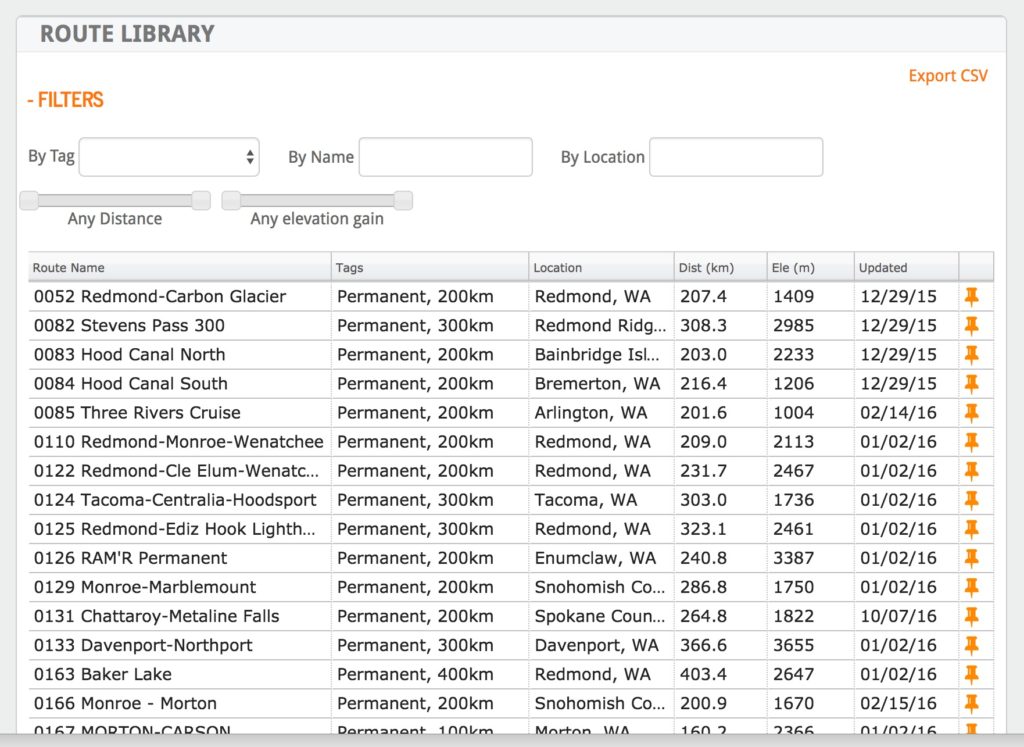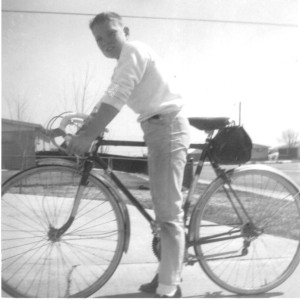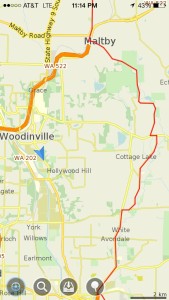Paul Johnson’s article on the joys of volunteering appeared in the May 2009 edition of American Randonneur. In it Paul quotes another randonneur who says “but I really volunteer because of some guys named Codfish and Ray who gave me a couple of mochas and a warm truck to sit in at the bottom of White Pass on the 600K last year. I was cold, really cold, …”. That quote was not mine, but it could have been, Paul’s mocha at that same control was a big help in finishing my first 600k. Thank you Paul.
If you are looking for a way to volunteer, Mark Thomas recently posted a list of volunteering opportunities.
Paul Blogs about randonneuring and all sorts of other things at The Dr Codfish Chronicles.
Dr. C on the Joys of Volunteering
By Paul Johnson

R-you-SA
Have you ever stopped to ask what the mission of RUSA, or your local Randonneuring club is? This from the RUSA Website: “What is RUSA? Randonneurs USA (RUSA) is a national organization whose goals are to promote randonneuring in the U.S. and provide service to American randonneurs and randonneuses.”
I considered asking how you thought RUSA is doing, but if you are reading this I assume you are a member, so the more appropriate questions is, how are you doing? If you are a member, you are RUSA and it is incumbent upon you to do your part to “promote randonneuring in the U.S. and provide service to American randonneurs and randonneuses.”
Achieving the Goals
Now you might think that paying your annual dues, getting out on your bike and riding brevets, talking it up with your co-workers over the water cooler is enough. By now I’m sure you can see where this is headed. Tact has been described as the art of making your point without skewering someone with it. I’ll be tactful but the point is, you should do more.
Consider that this organization is run exclusively by volunteers. Though the president and board are probably worthy of huge retention bonuses, we’ve all seen recently how that can backfire, so all the high powered execs at RUSA get for their good work is…more work. What do I mean? Well look at our membership statistics, the number of events we put on, the number of kilometers ridden year by year, the number of medals, awards, and other outputs and this can only be seen as more work. In fact, in my short time as a member I have been just amazed at the growth of our sport and our club. My concern is that the number of volunteers has not grown with our sports popularity.
In prepping this article I sent an inquiry around to a few folks to get their thoughts. I asked all the RBAs and a selection of regular, run-of-the-mill members, some of whom are “habitual offenders” and a few who are new to the sport and to volunteering. Here are the questions I asked:
- Why do you volunteer?
- How does volunteering for randonneuring events differ from your other (if any) volunteering efforts?
- Can you relate a memorable event? (keep it short)
What They Said
The responses varied, some were predictable and some were surprising.
One predictable answer I got was that the person just didn’t have time to respond. In my work life I often provide assistance to start up organizations and volunteer groups. There is an old adage that holds true: If you want to get something done, find a busy person. Busy people often have to make decisions about what they can engage in and in this case this person was focused more on doing than on talking about doing. It was a great response.
One of the RBA’s, for a club that puts on a LOT of brevets down south said point blank that if more people volunteered to help out, they could put on even more events. I think that is probably true everywhere. Though your club may put on enough events for you, imagine what it would be like if you had a choice of several different events in different locations on a given weekend in the summer. Sound over the top? Well, let the idea roll around in your noggin and then go back to the RUSA mission and ask yourself how more opportunities might help promote randonneuring (remember… the goal?) It may seem preposterous now but I imagine that just 10 years ago the founders of RUSA might not have believed that there would over 2,300 members in 2009.
How To Get Started
The most obvious thing you can do for your club is to volunteer to help out on a brevet. I recently read a ride report that gushed with gratitude for the help that volunteers offered at a control on a particularly challenging brevet. It’s true that we value self sufficiency but who hasn’t rolled into a control at one time or another and been absolutely thankful for a person who takes the bike and hands you a hot (or cold) beverage, a cup-O-noodles, an ice cold soda, and maybe a beat up lawn chair (or a warm pick up cab) to relax and recover in for a few minutes? If you’ve taken advantage of this kindness you know exactly what I am talking about, and if you haven’t, believe me, it is really wonderful to see that such a little gesture can be so warmly received.
If your idea of randonneuring is just showing up at the start, riding the brevet, and turning your card in, you need to rethink your relationship to the sport. You may take exception to that notion but here is an undeniable fact: If it were not for volunteers, you wouldn’t have any events to show up for!
I like doing this myself. I have noticed, and others I interviewed mentioned that you get a look at every rider: you get to see how the fast fish get it done (I never see these people after the start otherwise) you can see how the mid-packers get around the course and your personal assistance can encourage a newbie, or even an old hand at the back of the pack to soldier on, at least to the next control when they might otherwise have handed in their brevet card.
You will also be taking a little of the pressure off those I refer to as “habitual offenders.” Every club has a small cadre of folks who show up year in and year out to volunteer at events. It’s really not fair for you to just show up to ride and assume that someone else will always take care of the logistics.
Make it Fun
Volunteering to run a control also offers an opportunity to put your own personal stamp on the event. I once ran a nighttime control on a late season 1000K brevet. The riders had just descended off Elk pass in the first snow of the fall; they were really cold when they got into our stop. Mrs. C and I had set up a cozy little nest in a campground, and I’d built a big bonfire. The Coleman camp stove was steaming away with coffee and clam chowder. We had lounge chairs, cuppa noodles, sandwiches, chips and cookies: the whole nine yards. The few riders on the event were thrilled to have the warmth. It was a real kick for my wife and me.
The Dog Ate My Homework
There are a lot of reasons not to volunteer. Most are based on a lack of information. “I’ve never done it before,” “I don’t have time,” “I don’t know enough to put on a brevet.” The list goes on. First, just realize that no one was born knowing it all. There was a time when you had never ridden a brevet before, right? Shoot, believe it or not, there was a time when you didn’t even know how to ride a bicycle. Where would you be if your folks had let the “I don’t know how” defense stand? Now you’re a super rando (sorry, no cape awarded) or at least you know how to ride a brevet. If you’ve ridden even one brevet you already know about 90 percent of what you need to volunteer. The other 10 percent is just details.
You will not be expected to jump off the cliff all alone. I guarantee that if you let someone know that you are willing to help out you will be supported to your own personal level of comfort. Once you’ve staffed a control, you will know almost everything there is to know to do it again alone. From there it is a quick slide down the slippery slope to organizing your own brevet. One more brevet organizer means one less event that the “regulars” have to gear up for. And you gain instant cred: You’ll be one of the “old hands!”
You’ll be on the short list for a ridiculously huge retention bonus when the stimulus package arrives. Again, you’ll have all the help and guidance needed to assure that you don’t fumble the ball.
Probably the best reason I can give you to try this is captured in this surprise answer I got from one of the people I queried. Really, I’m not making this up:
“But I really volunteer because of some guys named Codfish and Ray who gave me a couple of mochas and a warm truck to sit in at the bottom of White Pass on the 600K last year. I was cold, really cold, and I was having thoughts that I might actually be in danger. But there in the distance was a SIR sign with a little blinky light. It was a big deal, and it helped me finish that ride. When I thanked you later for your help, I think you said something like, ‘think about supporting some event too.’ That, my friend was a ‘teachable moment.’”
This was totally unexpected and I would like to say when I read it the moment came rocketing back into my memory. The truth is Ray and I stuffed a number of guys in that truck to warm them up and Joe was just one of the shivering faces with blue lips poking out under a helmet that needed a few moments to get the circulation back in the fingers and toes to get ready to take on Cayuse pass and the home stretch.
The take-home message is that these efforts not only help riders go along their way, but they very likely inspire others to do the same. The need to “pay it forward” is strong in our community and your effort will make a difference in ways you can’t really imagine.
Keep in mind, Paul Revere is not remembered for what he did 9 to 5, but for his volunteer efforts, and look what a difference he made in the world, (Revere Ware notwithstanding).




